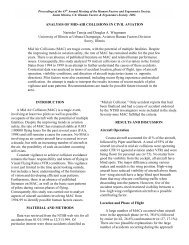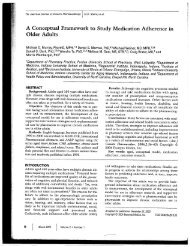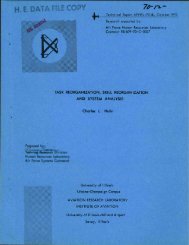Defining and Assessing Safety Culture in High Reliability Systems
Defining and Assessing Safety Culture in High Reliability Systems
Defining and Assessing Safety Culture in High Reliability Systems
Create successful ePaper yourself
Turn your PDF publications into a flip-book with our unique Google optimized e-Paper software.
Bierly, P. E., & Spender, J. C. (1995). <strong>Culture</strong> <strong>and</strong> high reliability organizations: The case<br />
of the nuclear submar<strong>in</strong>e. Journal of Management, 21(4), 639-656.<br />
Features of high-risk organizations (HRKOs) are complexity, tight coupl<strong>in</strong>g, <strong>and</strong> the potential for<br />
catastrophes. Accord<strong>in</strong>g to Perrow, accidents are normal for HRKOs because of the<br />
irreconcilable structural paradoxes: centralization <strong>and</strong> delegation. Centralization, for deal<strong>in</strong>g with<br />
tight coupl<strong>in</strong>g, must be comb<strong>in</strong>ed with delegation, for deal<strong>in</strong>g with complexity. In contrast,<br />
Weick argues that strong organizational cultures provide a centralized <strong>and</strong> focused cognitive<br />
system with<strong>in</strong> which delegated <strong>and</strong> loosely coupled systems can function effectively. HRKOs<br />
thereby become transformed <strong>in</strong>to high-reliability organizations (HRLOs).<br />
Bierly <strong>and</strong> Spender, focus<strong>in</strong>g on the nuclear submar<strong>in</strong>e, argue for a multilevel model <strong>in</strong> which<br />
culture <strong>in</strong>teracts with <strong>and</strong> supports formal structure thereby produc<strong>in</strong>g high reliability. As shown<br />
<strong>in</strong> Rickover’s example, NR culture, through a powerful system of selection <strong>and</strong> tra<strong>in</strong><strong>in</strong>g, supports<br />
the formal structure of comm<strong>and</strong> aboard the submar<strong>in</strong>e <strong>and</strong> provides a framework with<strong>in</strong> which<br />
<strong>in</strong>dividuals at all levels can monitor, advise, criticize <strong>and</strong> support each other. Centralization<br />
based at the collective level can coexist with decentralization at the <strong>in</strong>dividual level, therefore a<br />
high-risk system can be transformed <strong>in</strong>to a high-reliability system.<br />
Butterfield, D. A., & Farris, G. F. (1974). The Likert organizational profile: Methodological<br />
analysis <strong>and</strong> test of System 4 theory <strong>in</strong> Brazil. Journal of Applied Psychology, 59(1), 15-23.<br />
The Likert Organizational Profile (LOP) is a 20-item, 20-po<strong>in</strong>t scale. The 20-po<strong>in</strong>t scale is<br />
divided <strong>in</strong>to four sections, each section represent<strong>in</strong>g one of the four management systems<br />
described by Likert’s theory:<br />
(1) Authoritative,<br />
(2) Benevolent authoritative,<br />
(3) Consultative, <strong>and</strong><br />
(4) Participative group.<br />
The 20 items are grouped <strong>in</strong>to six theoretical dimensions of organizational processes: leadership,<br />
motivation, communication, decision-mak<strong>in</strong>g, goal sett<strong>in</strong>g, <strong>and</strong> control.<br />
LOP was adm<strong>in</strong>istered twice <strong>in</strong> 13 Brazilian development banks to obta<strong>in</strong> the actual <strong>and</strong> ideal<br />
bank profiles. The result showed that participative group management methods were ideal, but<br />
autocratic or consultative methods were actually used. Factor analyses did not yield the six<br />
dimensions predicted by Likert’s theory. Factors were only partially consistent over time <strong>and</strong> for<br />
different hierarchical levels. Retrospective scores were accurate <strong>and</strong> were equally so for the 6-,<br />
12-, <strong>and</strong> 18-month time periods s<strong>in</strong>ce the orig<strong>in</strong>al adm<strong>in</strong>istration. Test-retest reliability of the<br />
LOP as a whole was moderate. Bank LOP scores were unrelated to objective measures of<br />
organizational effectiveness, but were positively related to employee subjective satisfaction. The<br />
LOP appears useful for current <strong>and</strong> retrospective organizational studies, but the theory of<br />
management systems it measured is only partially supported.<br />
4















